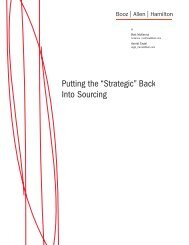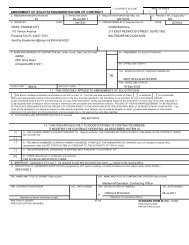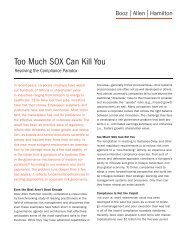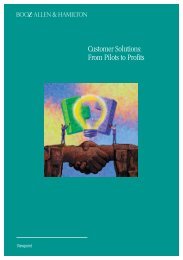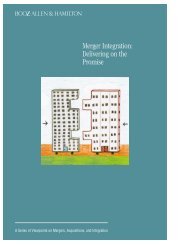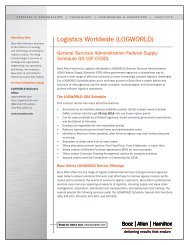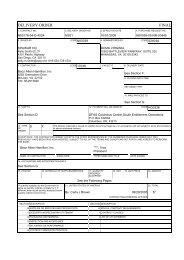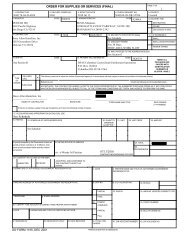Building the Enterprise - Booz Allen Hamilton
Building the Enterprise - Booz Allen Hamilton
Building the Enterprise - Booz Allen Hamilton
- No tags were found...
You also want an ePaper? Increase the reach of your titles
YUMPU automatically turns print PDFs into web optimized ePapers that Google loves.
For example, it is easy to documenthow much money is budgetedfor a particular job training program,how many training classes that moneybuys, <strong>the</strong> number of people whoapply for and complete classes andeven <strong>the</strong> number who get jobs. However,it is difficult to determine causeand effect, that is whe<strong>the</strong>r traineesgot jobs as a result of <strong>the</strong> program.We recommend <strong>the</strong> establishmentof an Office of Evaluation, independentof agencies, within <strong>the</strong>Executive Office of <strong>the</strong> President orOMB, to conduct rigorous performanceassessments that will determineif programs are meeting <strong>the</strong>irgoals. This information will assistenterprise goal leaders, <strong>the</strong> PMCand OMB in making judgments onprogram effectiveness and on waysto make improvements. As one governmentofficial observed, “Whathas struck me is how few programevaluations are really done. Thereare 47 employment training programsand only four have had anyevaluations. There are some 18 foodand nutrition programs and onlythree of <strong>the</strong>m have had any substantiveevaluations. It’s very difficult todeal with <strong>the</strong> problems if you don’tknow which programs are workingwell and which ones are not.”The evaluation office should bepositioned, staffed and funded totake full advantage of today’s revolutionof big data, with access to <strong>the</strong>government’s vast data resourcesand an analytic staff of <strong>the</strong> best andbrightest evaluators.The office must be positionedto evaluate <strong>the</strong> portfolios of relatedprograms, ra<strong>the</strong>r than just one ortwo in isolation, and make judgmentson how <strong>the</strong>y contribute collectivelyand separately to a particularoutcome to provide goal leaderswith informed assessments.Since evaluation of governmentprograms can easily become ensnaredin politics, <strong>the</strong> office must beled by a respected career executiveon a seven-year term and administrativelyfirewalled from outsideinfluence. Only <strong>the</strong>n can it help goalleaders make hard calls.In keeping with objectives oftransparency and public accountability,<strong>the</strong> office should provideaccess to full performance data onportfolios and <strong>the</strong>ir programs on<strong>the</strong> Performance.gov website, unlessclassified or containing personallyidentifiable information. The missionof <strong>the</strong> assessment office won’tbe easy. One interviewee noted thatassessing and measuring whe<strong>the</strong>rprograms are producing results willtake “relentless, sometimes evenruthless, follow-through.”To get <strong>the</strong> attention of departmentand agency officials accountablefor programs, <strong>the</strong> evaluationoffice should issue program scorecardsto make <strong>the</strong> results of <strong>the</strong>evaluations clear and impactful. TheGeorge W. Bush administration useda scorecard to measure agency progressand effectiveness in each of itsfive management reform areas. Oneinterviewee noted that PresidentBush regularly asked Cabinet membersabout <strong>the</strong>ir red, green or yellowstatus on <strong>the</strong> scorecard. “I don’tknow how much he knew aboutit, or how much <strong>the</strong> Cabinet headsknew about it, but <strong>the</strong>y knew <strong>the</strong>ydidn’t want to be red or yellow. It gotpeople’s attention.” The system usedeasily understood stoplight ratings—green for success, yellow for mixedresults and red for unsatisfactory. •The five strategies recommended so far focus on improving<strong>the</strong> effectiveness of departments and agencies as<strong>the</strong>y confront today’s cross-cutting mission challenges.The enterprise approach also will produce order-of-magnitudeimprovements in efficiency by compelling agenciesto integrate across <strong>the</strong> resource base of <strong>the</strong> governmentas a whole. By treating commonly purchasedgoods and services as elements of a federal commons,ra<strong>the</strong>r than agency property, <strong>the</strong> enterprise approachwill accelerate nascent efforts to reduce duplication. Theenterprise will leverage economies of scale and provideor procure better, cheaper common goods and servicesranging from email and data storage to personnel andpayroll support, and almost everything in between. Theapproach also will rebuild <strong>the</strong> civil service as a more cohesiveand agile corps. The following are strategies to accomplish<strong>the</strong>se goals.16 PARTNERSHIP FOR PUBLIC SERVICE | BOOZ ALLEN HAMILTON





